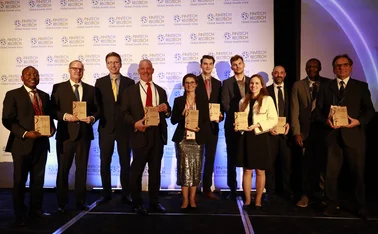
Economics in central banking: ‘Patterns in invoicing currency in global trade’, Emine Boz, Camila Casas, Georgios Georgiadis, Gita Gopinath, Helena Le Mezo, Arnaud Mehl and Tra Nguyen
An extensive data-gathering exercise allowed the authors to shed new light on critical aspects of policy-making in a globalised world

Little more than 10 years on from the global financial crisis, the markets crisis triggered by Covid-19 served as another reminder of the tight financial interlinkages in the global economy, as well as its heavy reliance on the US dollar. Launched against such a turbulent backdrop, the International Monetary Fund working paper Patterns in invoicing currency in global trade looks particularly prescient.1 Its July 2020 publication was well-timed to help central banks consider how they might rework their policy frameworks to be more resilient to the tides – and tidal waves – of global capital.
The paper presents the results of an extensive data-gathering exercise on global invoicing currencies, filling an empirical void that existed alongside economists’ increasingly detailed theoretical understanding of dominant-currency pricing. The results add weight to an ongoing rethink of the Mundell-Fleming model, a workhorse of international economics, with implications for how the IMF advises its members and for the way central banks apply their policy tools.
The list of authors on the paper – from the IMF, European Central Bank and (when the paper was published) Central Bank of Colombia – attests to the scale of the challenge they took on. Between 2019 and 2020, Emine Boz, Camila Casas, Georgios Georgiadis, Gita Gopinath, Helena Le Mezo, Arnaud Mehl and Tra Nguyen compiled what is now the world’s most comprehensive and up-to-date panel dataset on trade invoicing. The researchers gathered information on trade invoiced in US dollars, euros and local currency for a list of more than 100 countries, stretching back to 1990.
“Macroeconomic policies have been guided for long by the assumption that the use of a country’s currency in world trade is closely tied to its share in world trade,” says Gopinath, the head of the IMF research department.
“This new dataset on currency of invoicing in trade builds on previous research and further demonstrates that there is little support for this assumption. Policies therefore need to be designed for a world with strong asymmetries in the use of currencies, including the dominant role of the dollar.”
Georgiadis, a senior economist at the ECB, says gathering the data was a major challenge for the researchers. In some cases, the relevant data was held by central banks, making it easier to track down, but in others, the team had to establish new contacts at statistical or customs agencies.
“That took us a lot of time, and, in many cases, involved a lot of low-key detective work on Google and even Facebook,” he tells Central Banking.
On top of everything else, the researchers were still gathering data when the pandemic struck: “Everyone was working from home, and then we came and asked them to compile data for us, which they had never done before.”
Yet, the hard empirical work has paid off. It allowed the team to confirm some results from earlier work – such as the ongoing dominance of the dollar – and reveal new results of their own. One important fact the data highlights is how both the US dollar and euro have grown their share of trade invoicing in recent years. It also shows how a country’s circumstances and history matter for the choice of trade currency. A clear example from the paper is how membership of the eurozone or European Union, or simply a country’s candidacy to join the blocs, contributes to a rise in the euro’s share. Similarly, many countries in Africa have a higher propensity to use the euro, seemingly due in part to former colonial ties.
The dominance of one currency or another, although partly determined by historical accident, has major implications for how shocks transmit to the economy. The authors use the dataset to test how the ‘vehicle currency’ of trade shapes the exchange rate’s pass-through to import prices and volumes. Changes in the US dollar exchange rate turn out to have a greater impact than changes in the bilateral exchange rate between the currencies of importer and exporter. In turn, that has profound implications for whether a central bank should let its exchange rate float, or whether to intervene.

“Dollar invoicing is so massive, it is eye-opening to see the impact of the dollar when you start taking into account the share of invoicing in a certain currency,” says Casas, who worked for the Central Bank of Colombia as an economist at the start of the project, and later joined the IMF.
She notes the findings could help central banks explain results that seemed anomalous in the context of the Mundell-Fleming view of the world, where exchange rate flexibility helps a country adapt to external shocks. The Mundell-Fleming model assumes companies invoice in domestic currency, but if companies really do a large share of their invoicing in dollars, a depreciation of the domestic currency may not be expansionary.
One of the project’s most valuable contributions is that the dataset opens other research avenues: in fact, new applications of the data are already emerging. Georgiadis and Mehl are looking into the determinants of trade invoicing, as part of which they are now working to extend the dataset to include trade in renminbi. Casas is involved in work to examine the flip side of trade: the financing of firms, where dominant currencies likewise play an important role.
External researchers have now started to tap into the data, as well.
“We would love that people take the data, do some research, and enhance our understanding of all the issues that surround international trade invoicing,” says Mehl, an adviser at the ECB.
The aim will be to keep the dataset up to date, although updates are likely to happen every two or three years, rather than annually. Mehl notes how “costly and time-consuming” the data-gathering exercise was.
“A good measure of our success would be that other people start using the data to answer a broad range of questions in international macro,” says Casas.
“The data is very versatile – the more people that use it, the better.”
Note
1. Boz, Emine, Casas, Camila, Georgiadis, Georgios, Gopinath, Gita, Le Mezo, Helena, Mehl, Arnaud, and Tra Nguyen, Patterns in invoicing currency in global trade, International Monetary Fund, July 2020.
The Central Banking Awards were written by Christopher Jeffery, Daniel Hinge, Dan Hardie, Rachael King, Victor Mendez-Barreira, William Towning and Alice Shen
Only users who have a paid subscription or are part of a corporate subscription are able to print or copy content.
To access these options, along with all other subscription benefits, please contact info@centralbanking.com or view our subscription options here: http://subscriptions.centralbanking.com/subscribe
You are currently unable to print this content. Please contact info@centralbanking.com to find out more.
You are currently unable to copy this content. Please contact info@centralbanking.com to find out more.
Copyright Infopro Digital Limited. All rights reserved.
As outlined in our terms and conditions, https://www.infopro-digital.com/terms-and-conditions/subscriptions/ (point 2.4), printing is limited to a single copy.
If you would like to purchase additional rights please email info@centralbanking.com
Copyright Infopro Digital Limited. All rights reserved.
You may share this content using our article tools. As outlined in our terms and conditions, https://www.infopro-digital.com/terms-and-conditions/subscriptions/ (clause 2.4), an Authorised User may only make one copy of the materials for their own personal use. You must also comply with the restrictions in clause 2.5.
If you would like to purchase additional rights please email info@centralbanking.com






